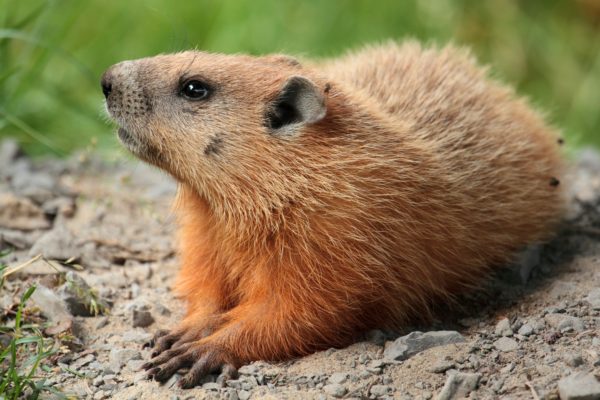Living with Wildlife – Groundhogs
by Ontario SPCA and Humane Society | Wildlife Fact Sheets | February 2, 2019

In an effort to coexist with wildlife, consider the enormous hardships these intelligent and fascinating wild species encounter because so much of their habitat has been destroyed. Each year they are forced into closer contact with humans and must compete with us for food, shelter and space. With a little understanding, patience and a few precautions and common sense steps, we can all enjoy the wonderfully interesting wild animals who share our backyards and cities.
Groundhogs, a member of the squirrel family, are famous because of “Groundhog Day” in February, when they “predict” how much longer winter will last. Adult groundhogs typically weigh between five to 10 pounds and are approximately 20 inches long. They are light to dark brown in colour and have short tails. Groundhogs hibernate for about five months commencing when cold weather begins.
Habitat
Groundhogs are natural inhabitants of forested areas, but they have adapted and prospered in close proximity to human activity. Groundhogs are common residents near agricultural pastures, croplands, backyards and wooded areas such as urban parks. They live in complex burrows with separate spaces for their different needs, and multiple entrance/exit holes.
Diet
Primarily herbivores, groundhogs eat grasses, leaves, berries, dandelions and clovers. Groundhogs will also munch on garden vegetables and fruit when the opportunity arises.
Reproduction
Breeding period occurs in the spring, and, approximately one month after mating a litter of four to six are born. The young mature quickly and are independent by midsummer.
Common questions:
Groundhogs are eating my vegetables. What can I do?
Groundhogs are easily frightened so making frequent visits to your garden may be enough to deter them. Constructing a scarecrow that makes noise and moves when the wind blows can also be suitable to scare away groundhogs. However, if the groundhog is more persistent there are a number of solutions. The most permanent way to keep groundhogs out of your garden is to exclude them with a fence. The fence only needs to be about three feet high. To stop groundhogs from burrowing underneath, the fence should be buried about one foot beneath the ground, with a section of the fence facing outwards in a backwards ‘L’ shape. If fencing is not an option, you can cover the plants with milk jugs with the bottom cut out, or covers can be purchased from garden supply stores.
Repellents may also be used to deter groundhogs from your garden. There are also many homemade remedies you can try. A diluted solution of hot sauce (one tablespoon of hot sauce mixed in one gallon of water) sprayed directly on the veggies or around the perimeter of the garden may deter groundhogs. Remember to wash vegetables and fruit thoroughly before consuming them yourself.
Other easy deterrents to try are scare devices. Motion-sensitive lights, alarms, or sprinklers can be used to scare groundhogs away. You can also build your own scare device. Insert a pole into the ground near the garden and hang a metal garbage lid or pie plates on the post. When the wind blows this will create motion and noise to scare the groundhogs. You can also use scare tape which can be purchased at hardware or garden supply stores.
As burrowers, groundhogs can also be disturbed through the introduction of vibrations in the ground they inhabit. Spinning pinwheels can be installed at the entry. When the wind blows, the pinwheel spins and creates vibrations that groundhogs can feel and will dislike in their underground home. Another option is letting vegetation grow around the entry/exit hole. Restricted visibility at the entry/exit point of the burrow will make the groundhog feel insecure and may help encourage relocation.
There is a groundhog under my shed. How can I get rid of it?
If this problem has arisen in the summer months the groundhog is most likely a mother with young. In this case we encourage the homeowner to be tolerant and patient. Young do not leave the den until five to six weeks of age, and, until the homeowner notices the young leaving the burrow, no exclusion methods should be attempted. The best time to exclude groundhogs is late summer or early fall.
The first step in excluding a groundhog is to remove all vegetation near the entrance/exit hole, and to dig out the entrance/exit hole. Noise, light and odour deterrents can all be used to help convince the groundhog to vacate the burrow. Place a battery-powered radio tuned to an all-talk station at a fairly high volume near the burrow. Also, place a battery-powered light shining towards the burrow. These methods will disturb the groundhog and make her feel insecure and more likely to move out. You can also try the suggestion above regarding allowing vegetation to grow around entry/exit holes.
Once you suspect the groundhog has left, place some loose hay in the entrance/exit hole. If the hay is not disturbed for three to four days you can take steps to permanently seal the entrance hole. You will have to place heavy wire screening over the hole, and dig a one-foot wide by one-foot deep trench around the hole – placing heavy wire screen inside. You may also want to bend the screen to extend outwards (backwards ‘L’). Check the hole every couple days to ensure no animal is attempting to dig back into the burrow.
Categories
Testimonial
Thank you so much for all you do
Thank you so much for all you do every day to rescue animals in need. I can’t imagine the terrible situations that you see every day. It is great that you have the heart to help. Keep up the good work.
